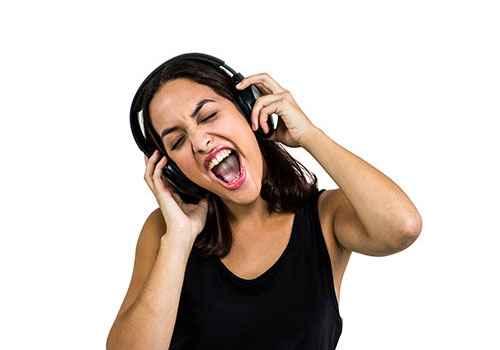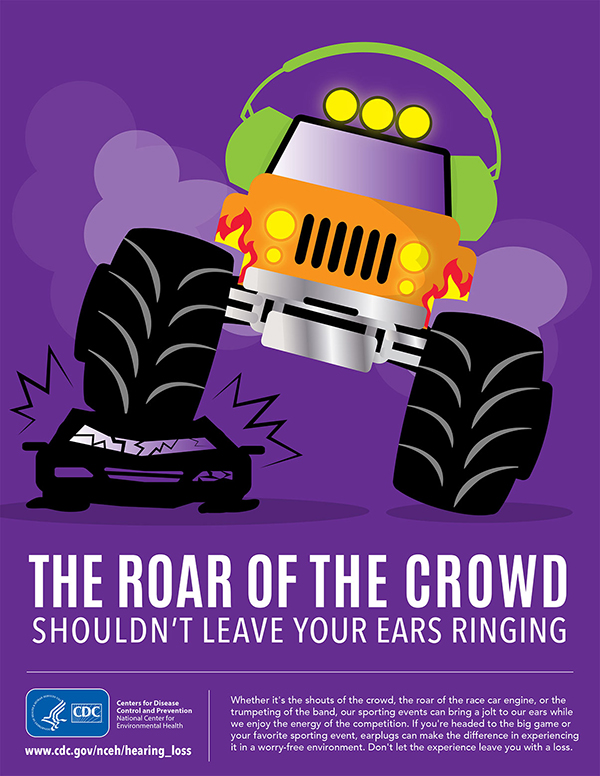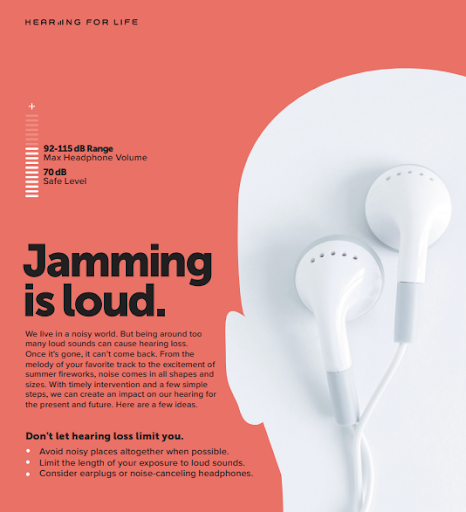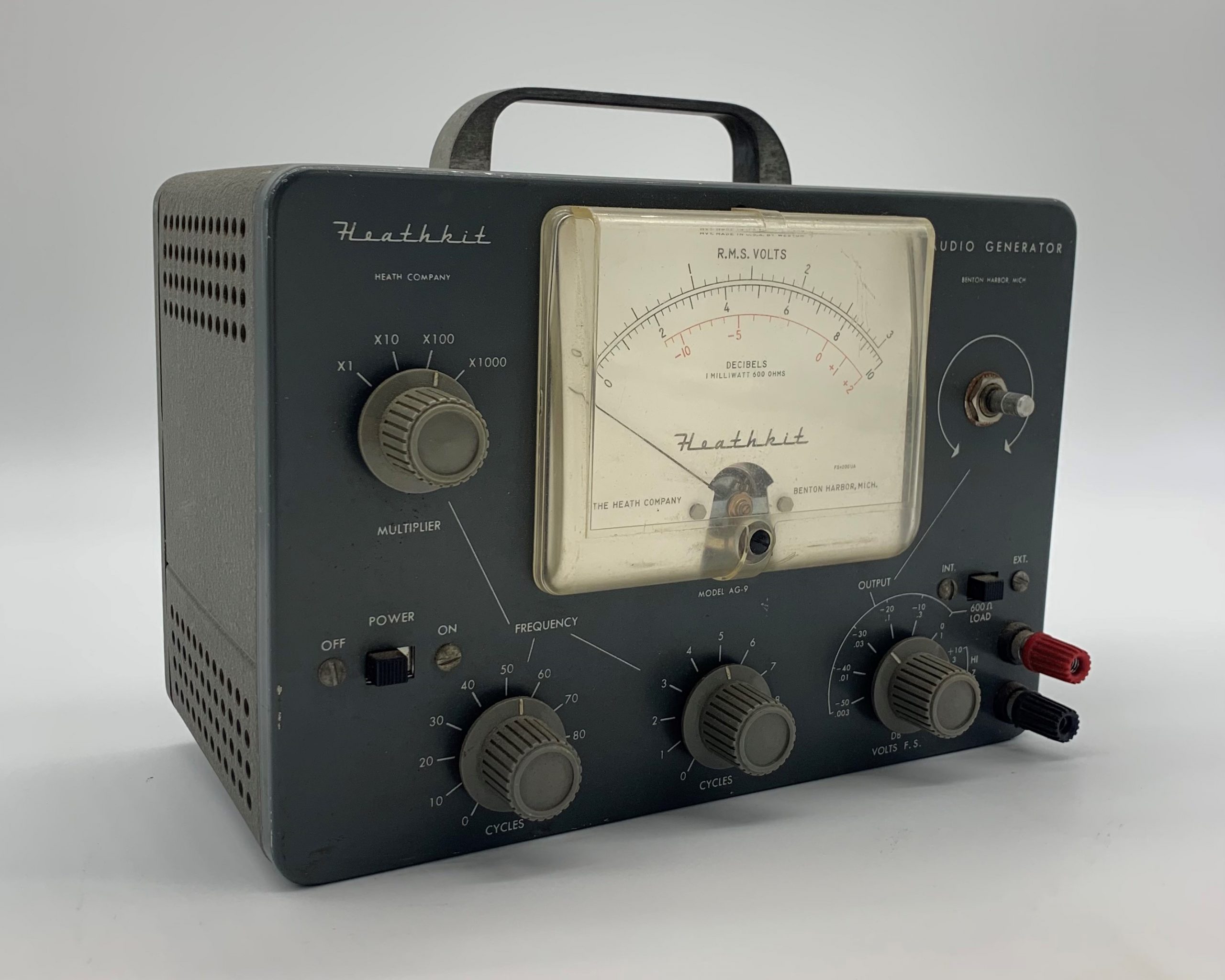Teen Newsletter: Noise-Induced Hearing Loss
November 2022
The David J. Sencer CDC Museum (CDCM) Public Health Academy Teen Newsletter was created to introduce teens to public health topics. Each newsletter focuses on a different public health topic that CDC studies. Newsletter sections include: Introduction, CDC’s Work, The Public Health Approach, Out of the CDC Museum Collection, and Teen Talk.

Hearing loss can result from damage to structures and/or nerve fibers in the inner ear that respond to sound. This type of hearing loss, termed “noise-induced hearing loss,” is usually caused by exposure to excessively loud sounds and cannot be medically or surgically corrected.
If you have any of these signs or symptoms, you may have hearing loss caused by noise:
- Speech and other sounds seem muffled
- Trouble hearing high-pitched sounds (e.g., birds, doorbell, telephone, alarm clock)
- Trouble understanding conversations when you are in a noisy place, such as a restaurant
- Trouble understanding speech over the phone
- Trouble hearing speech consonants (e.g., trouble hearing the difference between s and f, p and t, or sh and th in speech)
- Asking others to speak more slowly and clearly
- Asking someone to speak more loudly or repeat what they said
- Turning up the volume of the television or radio
Additionally, loud sound (noise) can damage sensitive parts of the ear, causing hearing loss, ringing or buzzing in the ear (tinnitus), and increased sensitivity to sound (hyperacusis). Loud noise can damage cells and membranes in the cochlea. Hair cells in the ear, similar to blades of grass, will bend more if the sound is louder. Listening to loud noise for a long time can overwork these hair cells, which can cause these cells to die (as demonstrated in the video below).
The effect of each noise on hearing depends on how loud it is (sound intensity) and how long it lasts (duration). The louder the sound, the shorter the amount of time it takes for hearing loss to occur. The longer the exposure, the greater the risk for hearing loss, especially when hearing protection is not used or there is not enough time for the ears to rest between exposures. The hearing loss will progress as long as the exposure continues. Harmful effects might continue even after noise exposure has stopped. In fact, damage to the inner ear or auditory neural system is generally permanent.
Therefore, avoiding noisy situations is the best prevention. If you can’t avoid the noise, use adequate hearing protection. Hearing protection devices reduce the level of sound entering your ear, but they do not block out sound completely.
It’s important to remember that hearing loss caused by exposure to loud sound is preventable. Prevention and early detection of hearing loss are important. If you have any signs of hearing loss or if you are at risk for hearing loss, get your hearing tested. To reduce their risk of noise-induced hearing loss, adults, teens and children can do the following:
- Identify sources of loud sounds that can contribute to hearing loss and try to reduce exposure
- Adopt behaviors to protect hearing:
- Avoid or limit exposure to excessively loud sounds
- Turn down the volume of music systems
- Move away from the source of loud sounds when possible
- Use hearing protection devices when it is not feasible to avoid exposure to loud sounds or reduce them to a safe level
- Seek hearing evaluation by a licensed audiologist or other qualified professional, especially if there is concern about potential hearing loss
At CDC, there are several areas that work on noise-induced hearing loss.
-
- The National Center for Environmental Health (NCEH) brings awareness to noise-induced hearing loss through their Hearing Loss Toolkit that includes fact sheets and posters, infographics, social content, and media.

- The National Institute for Occupational Safety and Health (NIOSH) recommends preventing hazardous noise to create a healthier workplace. Did you know noise-induced hearing loss is the most common work-related illness in the United States? Each year, approximately 22 million U.S. workers are exposed to noise loud enough to damage their hearing.
- The National Center for Chronic Disease Prevention and Health Promotion (NCCDPHP) offers BAM! Body and Mind Classroom Resources for Teachers to use in the classroom and help students make healthier lifestyle choices. BAM! Unit 7: Injury Prevention and Safety is all about preventing noise-induced hearing loss.
- The National Center for Environmental Health (NCEH) brings awareness to noise-induced hearing loss through their Hearing Loss Toolkit that includes fact sheets and posters, infographics, social content, and media.
Public health problems are diverse and can include infectious diseases, chronic diseases, emergencies, injuries, environmental health problems, as well as other health threats. Regardless of the topic, we take the same systematic, science-based approach to a public health problem by following four general steps.
For ease of explaining and understanding the public health approach for the public health problem of noise-induced hearing loss, let’s focus on adolescents.
- Surveillance (What is the problem?): In public health, we identify the problem by using surveillance systems to monitor health events and behaviors occurring among a population.
The following are surveillance systems/surveys that collect data on noise-induced hearing loss:
- The Behavioral Risk Factor Surveillance System (BRFSS) is a cross-sectional survey used to collect state and local data about U.S. residents regarding their health-related risk behaviors, chronic health conditions, and use of preventive services for public health issues like noise-induced hearing loss.
- The National Health and Nutrition Examination Survey (NHANES) is a program of studies that combines interviews and physical examinations (including audiological testing) to assess the health and nutritional status of adults and children in the United States.
- The National Health Interview Survey (NHIS) is a large-scale household interview survey that collects data on health status, health care access, and progress toward achieving national health objectives. NHIS collects information on self-reported hearing ability each year and periodically includes more extensive information on noise exposure and hearing.
- The Metropolitan Atlanta Developmental Disabilities Surveillance Program (MADDSP) tracks the number of eight-year-old children in a five-county area in metropolitan Atlanta, Georgia who have moderate to profound hearing loss in both ears.
An estimated 12.5% of adolescents aged 6–19 years (approximately 5.2 million) have suffered permanent damage to their hearing from excessive exposure to noise.
- Risk Factor Identification (What is the cause?): After we’ve identified the problem, the next question is, “What is the cause of the problem?” For example, are there factors that might make certain populations more susceptible to diseases, such as something in the environment or certain behaviors that people are practicing?
Sound is measured in decibels, and because people can’t hear all pitches of sound, we often use A-weighted decibels (dBA) to describe sound based on what human ears can actually hear. Sounds at or below 70 dBA are generally considered safe. Any sounds at or over 85 dBA are more likely to damage your hearing over time. The maximum volume on your mobile device is likely 94 to 110 dBA.

Certain people may be more susceptible to noise-induced hearing loss than others, meaning that individuals who experience identical noise exposure may develop different degrees of hearing damage.
While everyday sounds typically do not damage your hearing, many people participate in activities that produce harmful sound levels. Some examples include attending loud sporting events (94 to 110 dB), listening to music with headphones at the highest volume (96 to 110 dB), or standing too close to exploding firecrackers and fireworks (140 to 160 dB). Some other sources of loud noise that adolescents may be exposed to include restaurants, movie theaters, and music concerts. If you are repeatedly exposed to loud noises over time, they can cause hearing loss.
Additionally, genetic predisposition, age, exposure to cigarette smoke, and chronic conditions such as diabetes and hypertension can increase the risk of acquiring noise induced hearing loss.
- Intervention Evaluation (What works?): Once we’ve identified the risk factors related to the problem, we ask, “What intervention works to address the problem?” We look at what has worked in the past in addressing this same problem and if a proposed intervention makes sense with our affected population.
Prevention is the most effective strategy, since noise-induced hearing loss is irreversible and it is impossible to identify the most susceptible individuals. If you can’t avoid noise, use adequate hearing protection.
Headphone Tips:
- Choose headphones that block out the sound around you. If your over-the-ear or in-the-ear headphones have a good seal, you’ll be less likely to turn up the volume to drown out other sounds.
- Try to use headphones or earbuds for only one hour a day. Take regular breaks from your headphones or earbuds. If you listen for longer periods of time, lower your volume to reduce the overall impact on your ears.
- Don’t listen with just one earbud. It’s harder to hear the music and you might be tempted to turn up the volume, putting that one ear at serious risk.
- Implementation (How did we do it?): In the last step, we ask, “How can we implement the intervention? Given the resources we have and what we know about the affected population, will this work?”.
CDC developed a series of resources for teens that include videos, social media graphics, and posters available on the webpage, Teens on Noise-Induced Hearing Loss. These resources can help teens learn how to protect their hearing and plan for noisy environments. Parents of teens, healthcare professionals, educators, school administrators, and others who work closely with teenagers can share these resources to help reinforce their importance.
Follow three teens—Catherine, Savannah, Ainsley, as they talk about noise-induced hearing loss prevention. The resources below can help teens learn how to protect their hearing and plan ahead for noisy environments.

Using the public health approach helps public health professionals identify a problem, find out what is causing it, and determine what solutions/interventions work.

This month’s Out of the CDC Museum Collection features a Heathkit audio generator, also called a signal generator. This device generates various sounds at various frequencies. It is typically used to test the performance of equipment such as speakers, microphones, or any audio device. In the CDC’s Work (link to CDC’s Work section via anchor tags) section above you learned that NIOSH works to prevent noise-induced hearing loss to create a healthier workplace. NIOSH uses signal generators to test the performance of items like hearing protection and communication headsets to prevent hazardous noise. The Heathkit audio generator seen here was used around 1957. These days, almost all sound testing is done by digital software.
